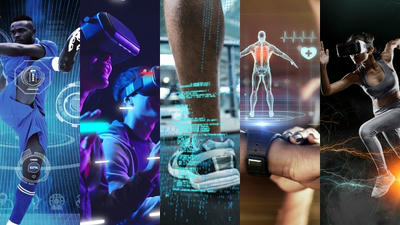
Transforming Athletic Potential: How 5 Cutting-Edge Sports Technologies Redefine Performance
The landscape of athletic achievement is undergoing a profound transformation, driven by an unprecedented surge in technological innovation. What was once the sole domain of raw talent and grueling physical exertion is now a meticulously quantified and optimized endeavor. This article delves into how five emerging sports technologies are not merely enhancing performance but fundamentally reshaping the very boundaries of human athletic capability and redefining what it means to train, compete, and recover in the modern era.
The integration of advanced technology into sports is rapidly shifting the paradigm from purely anecdotal training methods to data-driven, precision-engineered approaches. Its importance spans from elite professional sports, where marginal gains can determine championships, to amateur athletics, where it helps prevent injuries and improve personal bests. These innovations offer multifaceted impacts, providing athletes with real-time feedback, personalized insights, and unparalleled recovery tools, thus benefiting not only athletes but also coaches, sports scientists, and the broader healthcare community. Current developments include controversies around technological doping or fairness, as well as the ongoing race to unlock deeper physiological understanding. What impact would it have on our understanding or practice of athletic development if we failed to fully comprehend these rapidly evolving technological frontiers? The answer is clear: we risk falling behind in a world where data-driven optimization is becoming the new standard for peak performance.
Real-time Insights: The Power of Biometric Wearables and AI

Quantifying Effort and Optimizing Training Through Data
The advent of sophisticated biometric wearables, seamlessly integrated with artificial intelligence (AI), has revolutionized how athletes monitor their bodies and manage training loads. These devices, ranging from smartwatches and chest straps to intelligent apparel and subcutaneous patches, continuously collect a wealth of physiological data. Key metrics include heart rate variability (HRV), sleep patterns, recovery scores, skin temperature, and even blood oxygen saturation. HRV, for instance, measures the variation in time between heartbeats, providing a critical indicator of autonomic nervous system balance and an athlete's readiness to train or need for recovery. AI algorithms then process this raw data, identifying subtle patterns and trends that would be imperceptible to the human eye. This analysis allows for personalized training prescriptions, automatically adjusting intensity and volume based on an athlete's current physiological state, thus mitigating overtraining and reducing injury risk. Elite cyclists use power meters and AI platforms like INSCYD to optimize power output zones, while basketball teams leverage systems like Catapult Sports to track player load during practices and games. The goal is to move beyond generic training plans towards a truly individualized approach that maximizes adaptive responses and minimizes detrimental stress.
Beyond Limits: Engineering Performance with Advanced Materials
Innovating Gear for Speed, Protection, and Efficiency
Material science is continually pushing the boundaries of what athletic equipment can achieve, providing athletes with unparalleled advantages in speed, protection, and energy efficiency. Innovations in polymers, composites, and textiles are transforming everything from footwear to protective gear. For instance, the introduction of carbon fiber plates in running shoes, like Nike's Vaporfly series, creates a propulsion system that stores and releases energy more efficiently, demonstrably improving running economy. These plates, combined with lightweight, highly resilient foam midsoles (e.g., PEBA-based foams), offer superior cushioning and energy return compared to traditional EVA. Similarly, advanced composite materials like aerospace-grade carbon fiber are ubiquitous in cycling, tennis rackets, and hockey sticks, significantly reducing weight while increasing stiffness and power transfer. In protective gear, shear-thickening non-Newtonian fluids (e.g., D3O) are engineered to remain flexible under normal conditions but instantly stiffen upon impact, absorbing and dispersing energy more effectively than traditional foams.
These material advancements are not just about raw performance; they also enhance safety and durability. For example, modern helmets incorporating multi-directional impact protection systems (MIPS) reduce rotational forces during collisions, drastically lowering the risk of concussions. The synthesis of material science with biomechanical principles ensures that equipment is not just lighter or stronger, but actively enhances the body's natural mechanics, allowing athletes to perform closer to their absolute physical limits with greater safety.
To illustrate the impact of these material innovations, consider the evolution of racing shoe technology:
| Feature | Traditional Racing Flats (Pre-2017) | Modern Super Shoes (Post-2017) | Improvement Factor |
|---|---|---|---|
| Midsole Material | EVA (Ethylene-vinyl acetate) | PEBA (Pebax) Foam | Higher Energy Return |
| Plate Material | None or basic TPU | Full-length Carbon Fiber Plate | Enhanced Propulsion |
| Weight (avg. US9) | 200-250 grams | 180-200 grams | Lighter Weight |
| Energy Return | ~70-75% | ~80-85% | ~10-15% Boost |
This table highlights how the strategic integration of new materials like PEBA foam and carbon fiber plates has led to significant improvements in energy return and weight reduction, directly contributing to faster race times and reduced fatigue. This exemplifies how material engineering directly translates into measurable athletic advantages across various sports.
Immersive Development: Revolutionizing Skill Acquisition with VR/AR

Simulating Pressure and Perfecting Technique Virtually
Virtual Reality (VR) and Augmented Reality (AR) technologies are rapidly transforming athlete training by creating immersive, realistic environments for skill acquisition and cognitive development. VR allows athletes to step into highly specific scenarios without the physical risks, logistical hurdles, or costs of real-world training. For instance, baseball batters can face thousands of virtual pitches from different pitchers, football quarterbacks can practice reading defensive alignments, and basketball players can drill complex plays under game-like pressure. These systems often integrate haptic feedback, making the virtual experience feel more tangible. This ability to replicate high-stakes situations allows athletes to develop cognitive processing speed, decision-making skills, and spatial awareness in a controlled, repeatable manner.
AR, on the other hand, overlays digital information onto the real world, enhancing existing training facilities. Imagine a soccer player wearing AR glasses that project dynamic targets for shooting drills or visual cues for passing trajectories directly onto the field. Coaches can use AR to provide real-time feedback on form, line-of-sight, or movement patterns, offering immediate corrections during practice. Both VR and AR excel at providing thousands of repetitions in a safe, cost-effective, and highly customizable environment, a critical component for mastery in any sport. This technology is particularly beneficial for niche sports or situations where real-world practice is difficult or dangerous, such as bobsledding or high-altitude training simulations.
Conclusion
The journey through the realm of emerging sports technologies reveals a transformative era in athletic development. We've seen how biometric wearables and AI are providing unprecedented real-time physiological insights, moving training from generalized programs to hyper-personalized, data-driven optimization. Advanced material science, exemplified by carbon fiber composites and intelligent fabrics, is redefining equipment capabilities, enhancing performance, safety, and efficiency across numerous disciplines. Furthermore, the immersive power of VR and AR is revolutionizing skill acquisition, enabling athletes to hone cognitive function and physical technique in simulated, pressure-filled environments. Together, these technologies are not just incrementally improving performance; they are fundamentally shifting the paradigm of what is humanly possible, making elite-level insights more accessible and pushing the boundaries of athletic achievement further than ever before. This synthesis of human endeavor and technological innovation truly underscores the critical position these advancements hold in the future of sports.
Looking ahead, the trajectory of sports technology points towards even greater integration and personalization. Future trends suggest a convergence of these innovations, where bio-integrated sensors communicate seamlessly with AI coaches to recommend real-time equipment adjustments based on an athlete's physiological state and environmental conditions. Challenges will undoubtedly arise, particularly concerning data privacy, equitable access to these high-cost innovations, and the ethical considerations around "technological doping." Macro scientific policies will need to adapt to regulate these advancements, ensuring fair play while fostering innovation. Interdisciplinary integration, especially between sports science, genetics, neuroscience, and robotics, promises breakthroughs in areas like neuro-performance enhancement and fully autonomous injury prevention systems. The importance of continuous research cannot be overstated, as each iteration brings us closer to a future where athletic potential is unlocked not just through grit and talent, but through a harmonious symbiosis with cutting-edge technological intelligence, offering unparalleled prospects for human achievement.
Frequently Asked Questions (FAQ)

Q: How do these emerging technologies actually help prevent injuries in athletes? A: Emerging sports technologies contribute significantly to injury prevention through a multi-faceted approach centered on data, predictive analytics, and biomechanical precision. Firstly, wearable biometrics constantly monitor an athlete's physiological responses, such as heart rate variability (HRV), sleep quality, and training load (duration and intensity). By tracking HRV, for example, AI algorithms can detect early signs of fatigue or overtraining, indicating that the athlete's body is not adequately recovering. This allows coaches and trainers to proactively adjust training schedules, implement rest days, or modify exercise intensity before minor fatigue escalates into an overuse injury like a stress fracture or tendonitis. Secondly, motion capture and biomechanical analysis systems are crucial. These technologies use high-speed cameras and sensor arrays to create detailed 3D models of an athlete's movement patterns. They can identify subtle inefficiencies or imbalances in gait, throwing mechanics, or jumping techniques that might place undue stress on specific joints or muscles. For instance, a runner might have a slight pronation that, over thousands of repetitions, could lead to knee pain. The technology flags this deviation, allowing for corrective exercises, technique adjustments, or specialized footwear to mitigate the risk. Thirdly, advanced materials play a role in protective gear (e.g., helmets with MIPS technology to reduce rotational forces during impact, decreasing concussion risk) and supportive footwear that optimizes load distribution. Finally, AI-driven predictive analytics, fed by vast datasets of training, performance, and injury history, can identify patterns that correlate with future injury risk, allowing for pre-emptive interventions. This shifts the paradigm from reactive injury treatment to proactive injury prevention, keeping athletes safer and healthier throughout their careers.
Q: Are these advanced sports technologies primarily for elite professional athletes, or are they becoming accessible to amateur and everyday fitness enthusiasts? A: While many advanced sports technologies initially debut in elite professional sports due to their high development costs and the significant investment professional organizations can make, there is a clear and accelerating "trickle-down" effect into the amateur and everyday fitness markets. Several factors contribute to this increasing accessibility. Firstly, manufacturing costs decrease over time as technologies mature and economies of scale are achieved, making devices more affordable for the general public. For example, GPS running watches and basic heart rate monitors, once exclusive to professionals, are now commonplace and relatively inexpensive. Secondly, companies are developing simplified, user-friendly versions of complex professional tools. While a professional sports team might use a multi-thousand-dollar biomechanical lab, an amateur runner can access gait analysis services at a specialized running store using more affordable sensor-based systems. Similarly, consumer-grade wearables like smartwatches and fitness trackers offer many of the same biometric data points (heart rate, sleep tracking, activity levels) that elite athletes monitor, albeit sometimes with less clinical precision. Thirdly, the growth of subscription-based services and apps democratizes access to AI coaching and data analytics. An amateur cyclist can subscribe to a training platform that uses AI to personalize workouts based on their performance data, similar to how a pro team might use a bespoke system. The value proposition for amateurs is clear: enhanced performance, reduced injury risk, and a deeper understanding of their own body and progress. Therefore, while some bleeding-edge technologies remain the domain of the pros, the core benefits and foundational concepts are rapidly becoming integrated into accessible products and services, empowering a broader demographic to optimize their fitness journey.








